| Palestinian territoriesالأراضي الفلسطينية al-Arāḍī al-Filasṭīniyya | |
|---|---|
 Palestinian flag
Palestinian flag | |
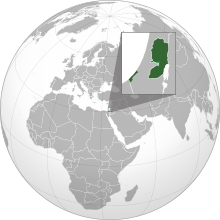 | |
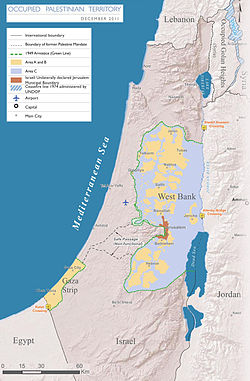 Palestinian territories according to a Green Line based definition Palestinian territories according to a Green Line based definition | |
| Largest cities | |
| Languages | |
| Ethnic groups | |
| Demonym(s) | |
| Area | |
| • Total | 6,220 km (2,400 sq mi) |
| • Water (%) | 3.5 |
| • West Bank | 5,860 km (of which Dead Sea: 220 km) |
| • Gaza Strip | 360 km |
| Population | |
| • Palestinians (2016) | 4,816,503 |
| • Settlers (2012) | 564,000 |
| • 2007 census | 3,719,189 (Pal.) |
| • Density | 654/km (1,693.9/sq mi) |
| HDI (2010) | 0.645 medium (97th) |
| Currency |
|
| Time zone | UTC+2 (EET) |
| • Summer (DST) | UTC+3 (EEST) |
| Drives on | Right |
| Calling code | +970 |
| ISO 3166 code | PS |
| Internet TLD | |
| |
The occupied Palestinian territories, also referred to as the Occupied Palestinian Territory and the Palestinian territories, consist of the West Bank (including East Jerusalem) and the Gaza Strip—two regions of the former British Mandate for Palestine that have been occupied by Israel since the Six-Day War of 1967. These territories make up the State of Palestine, which was self-declared by the Palestine Liberation Organization in 1988 and is recognized by 146 out of 193 UN member states.
The International Court of Justice (ICJ) employed the term Occupied Palestinian Territory in its advisory opinion of July 2004, titled "Legal Consequences of the Construction of a Wall in the Occupied Palestinian Territory". In its July 2024 advisory opinion, titled "Legal Consequences arising from the Policies and Practices of Israel in the Occupied Palestinian Territory, including East Jerusalem", the ICJ wrote "Territorial scope — Palestinian territory occupied since 1967 encompassing the West Bank, East Jerusalem and the Gaza Strip — The 'Occupied Palestinian Territory' constituting, from legal standpoint, a single territorial unit." The term Occupied Palestinian Territory was used by the United Nations and other international organizations between October 1999 and December 2012 to refer to areas controlled by the Palestinian National Authority. Since 2012, when Palestine was admitted as one of its non-member observer state, the United Nations has been using the name State of Palestine to describe the political entity but continues to use Occupied Palestinian Territory to describe the physical territory. The European Union (EU) also uses the term Occupied Palestinian Territory. The government of Israel and its supporters refer to these areas as "disputed territories".
The Gaza Strip and the West Bank were occupied by Egypt and Jordan, respectively, since the 1948 Arab–Israeli War until the Six-Day War of 1967. In 1967, Israel occupied both territories and has since maintained control. In 1980, Israel absorbed East Jerusalem and proclaimed the entire city to be its capital. The inclusion, though never formally amounting to legal annexation, was condemned internationally and declared "null and void" by the United Nations General Assembly. The Palestinian National Authority, the United Nations, international legal and humanitarian bodies and the broader international community regard East Jerusalem as part of the West Bank, and consequently, part of the Palestinian territories. The Palestinian National Authority never exercised sovereignty over the area, although it housed its offices in Orient House and several other buildings as an assertion of its sovereign interests. Israeli sovereignty over East Jerusalem has not been recognized by the International community on the grounds that the unilateral annexation of territory occupied during war contravenes the Fourth Geneva Convention. The World Bank estimates the annual cost to the Palestinian economy of Israeli occupation at $3.4 billion in 2013. The cost of the occupation for Israel over four decades (1967–2007) is estimated to be $50 billion.
In 1988, with the Palestine Liberation Organization (PLO) intention to declare a Palestinian State, Jordan renounced all territorial claims to the West Bank, including East Jerusalem. In 1993, following the Oslo Accords, parts of the territories politically came under the jurisdiction of the Palestinian National Authority (Palestinian enclaves, technically known as Areas A and B). Israel still exercised full military and civil control over 61% of the West Bank (Area C). The Oslo Accords established access to the sea for Gaza within 20 nautical miles from the shore. In the context of the Gaza–Israel conflict, the Berlin Commitment of 2002 reduced this to 12 miles (19 km). In October 2006, Israel imposed a 6-mile limit, and at the conclusion of the 2008–2009 Gaza War restricted access to a 3-nautical-mile limit, beyond which a no-go zone exists. As a result, in 2012 more than 3,000 Palestinian fishermen were denied access to 85% of the maritime areas agreed to in 1995. The majority of the Dead Sea area is off-limits to Palestinian use, and Palestinians are denied access to its coastline.
Israel disengaged from the Gaza Strip in 2005. The Hamas takeover of Gaza in 2007 divided the Palestinian territories politically. Abbas's Fatah largely ruled the West Bank and was recognized internationally as the official Palestinian (National) Authority. In 2009, the UN considered the West Bank and the Gaza Strip to still be occupied by Israel.
On 29 November 2012, UNGA 67/19 reaffirmed "the right of the Palestinian people to self-determination and to independence in their State of Palestine on the Palestinian territory occupied since 1967" and decided "to accord to Palestine non-member observer State status in the United Nations". The next month, a UN legal memorandum recognized Palestine's preference of the name "State of Palestine" with Mahmoud Abbas as its current leader. It was noted that there was no legal impediment to using the designation 'Palestine' to refer to the geographical area of the Palestinian territory. It was also explained that there was also no bar to the continued use of the term "Occupied Palestinian Territory including East Jerusalem" or such other terminology as might customarily be used by the UN General Assembly. The ISO adopted the name change in 2013. The UN Security Council continues to treat Palestine as a non-sovereign entity, preventing its admission to the UN General Assembly as a full member state. Israeli governments have maintained that the area involved is within territorial dispute. The extent of the territories, while subject to future negotiations, have frequently been revendicated by the Palestinian (National) Authority as the Green Line. Since the Palestinian Declaration of Independence in 1988, 146 UN Member Nations have recognized the State of Palestine. It has not been recognized by Israel and most Western nations, including the United States.
In 2014, Fatah and Hamas agreed to hold elections and form a compromise Unity Government. The government survived the 2014 Israel–Gaza conflict, but dissolved on 17 June 2015 after President Abbas said it was unable to operate in the Gaza Strip.
| Part of a series on |
| Palestinians |
|---|
 |
| Demographics |
| Politics |
|
| Religion / religious sites |
| Culture |
| List of Palestinians |
Name
See also: History of Palestine and Timeline of the name PalestineThe United Nations, the European Union, International Committee of the Red Cross, and the government of the United Kingdom, have used for many years the terms the "Occupied Palestinian Territory" or "Occupied Palestinian Territories".
The phrase "occupied Palestine" has been used by Palestinians to mean Israel although Professor Julie Peteet also says that this usage diminished with the advent of the peace process and PLO recognition of Israel. A parallel exists in the aspirations of David Ben-Gurion, Menachem Begin, to establish Jewish sovereignty over all of Greater Israel in trust for the Jewish people.
History
See also: History of Palestine, History of the Gaza Strip, and History of the Palestinian people| Part of a series on the |
|---|
| History of Palestine |
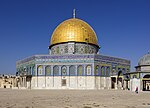 |
| Prehistory |
| Ancient history |
| Classical period |
| Islamic rule |
| Modern era |
|
|
In 1922, after the collapse of the Ottoman Empire that ruled Greater Syria for four centuries (1517–1917), the British Mandate for Palestine was established. Large-scale Jewish immigration from abroad, mainly from Eastern Europe took place during the British Mandate, though Jewish immigration started during the Ottoman period. The future of Palestine was hotly disputed between Arabs and Jews.
The 1947 United Nations Partition Plan proposed a division of Mandate Palestine between an Arab and a Jewish state, with Jerusalem and the surrounding area to be a corpus separatum under a special international regime. The regions allotted to the proposed Arab state included what became the Gaza Strip, and almost all of what became the West Bank, as well as other areas.
The Partition Plan was passed by the UN General Assembly in November 1947. The Partition Plan was accepted by the Jewish leadership, but rejected by the Arab leaders. The Arab League threatened to take military measures to prevent the partition of Palestine and to ensure the national rights of the Palestinian Arab population. One day before the expiration of the British Mandate for Palestine, on 14 May 1948, Israel declared its independence within the borders of the Jewish State set out in the Partition Plan. US President Harry Truman recognized the State of Israel de facto the following day. The Arab countries declared war on the newly formed State of Israel heralding the start of the 1948 Arab–Israeli War. Arab countries announced "an intervention in Palestine to restore law and order", heralding the start of the 1948 Palestine War.
After the 1947–1949 Palestine war, the 1949 Armistice Agreements established the separation lines between the combatants, leaving Israel in control of some of the areas designated for the Arab state under the Partition Plan, Transjordan in control of the West Bank, including East Jerusalem, Egypt in control of the Gaza Strip and Syria in control of the Himmah Area.
In 1950, Jordan annexed the West Bank. Only the United Kingdom formally recognized the annexation of the West Bank, excluding the case of East Jerusalem which was de facto recognized. In the Gaza Strip the Arab League formed the All-Palestine Government, which operated under Egypt occupation.
Article 24 of the Palestinian National Covenant of 1964, which established the Palestine Liberation Organization, stated: "This Organization does not exercise any territorial sovereignty over the West Bank in the Hashemite Kingdom of Jordan, on the Gaza Strip or in the Himmah Area" (i.e. the areas of the former Mandate Palestine controlled by Jordan, Egypt and Syria, respectively).
Israel captured both territories in the 1967 Six-Day War, as well as other territory belonging to Egypt and Syria. Since then, these territories have been designated Israeli-occupied territories. Immediately after the war, on 19 June 1967, the Israeli government offered to return the Golan Heights to Syria, the Sinai to Egypt and most of the West Bank to Jordan in exchange for peace. At the Khartoum Summit in September, the Arab parties responded to this overture by declaring "no peace with Israel, no recognition of Israel and no negotiations with Israel."
UN Security Council Resolution 242 introduced the "Land for Peace" formula for normalizing relations between Israel and its neighbors. This formula was used when Israel returned the Sinai Peninsula to Egypt in 1979 in exchange for a peace treaty. While that treaty mentioned a "linkage" between Israeli–Egyptian peace and Palestinian autonomy, the formerly Egyptian-occupied territory in Gaza was excluded from the agreement, and remained under Israeli control.
The Oslo Accords of the early 1990s between the Palestine Liberation Organization and Israel led to the creation of the Palestinian Authority. This was an interim organization created to administer a limited form of Palestinian self-governance in the territories for a period of five years during which final-status negotiations would take place. The Palestinian Authority carried civil responsibility in some rural areas, as well as security responsibility in the major cities of the West Bank and the Gaza Strip. Although the five-year interim period expired in 1999, the final status agreement has yet to be concluded despite attempts such as the 2000 Camp David Summit, the Taba summit, and the unofficial Geneva Accords.
Modern evolution of Palestine 1916–1922 various proposals: Three proposals for the post World War I administration of Palestine. The red line is the "International Administration" proposed in the 1916 Sykes–Picot Agreement, the dashed blue line is the 1919 Zionist Organization proposal at the Paris Peace Conference, and the thin blue line refers to the final borders of the 1923–48 Mandatory Palestine.
1916–1922 various proposals: Three proposals for the post World War I administration of Palestine. The red line is the "International Administration" proposed in the 1916 Sykes–Picot Agreement, the dashed blue line is the 1919 Zionist Organization proposal at the Paris Peace Conference, and the thin blue line refers to the final borders of the 1923–48 Mandatory Palestine.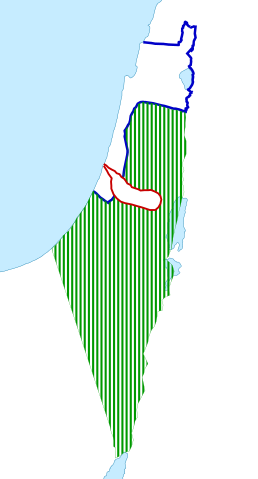 1937 British proposal: The first official proposal for partition, published in 1937 by the Peel Commission. An ongoing British Mandate was proposed to keep "the sanctity of Jerusalem and Bethlehem", in the form of an enclave from Jerusalem to Jaffa, including Lydda and Ramle.
1937 British proposal: The first official proposal for partition, published in 1937 by the Peel Commission. An ongoing British Mandate was proposed to keep "the sanctity of Jerusalem and Bethlehem", in the form of an enclave from Jerusalem to Jaffa, including Lydda and Ramle.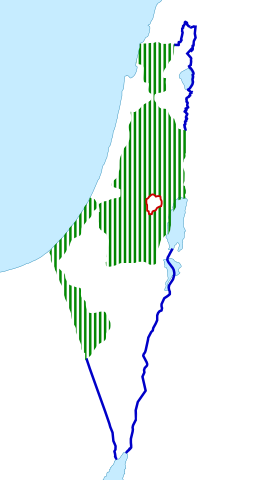 1947 UN proposal: Proposal per the United Nations Partition Plan for Palestine (UN General Assembly Resolution 181 (II), 1947), prior to the 1948 Arab–Israeli War. The proposal included a Corpus Separatum for Jerusalem, extraterritorial crossroads between the non-contiguous areas, and Jaffa as an Arab exclave.
1947 UN proposal: Proposal per the United Nations Partition Plan for Palestine (UN General Assembly Resolution 181 (II), 1947), prior to the 1948 Arab–Israeli War. The proposal included a Corpus Separatum for Jerusalem, extraterritorial crossroads between the non-contiguous areas, and Jaffa as an Arab exclave.
 1947 Jewish private land ownership: Jewish-owned lands in Mandatory Palestine as of 1947 in blue, constituting 7.4% of the total land area, of which more than half was held by the JNF and PICA. White is either public land or Palestinian-Arab-owned lands including related religious trusts.
1947 Jewish private land ownership: Jewish-owned lands in Mandatory Palestine as of 1947 in blue, constituting 7.4% of the total land area, of which more than half was held by the JNF and PICA. White is either public land or Palestinian-Arab-owned lands including related religious trusts.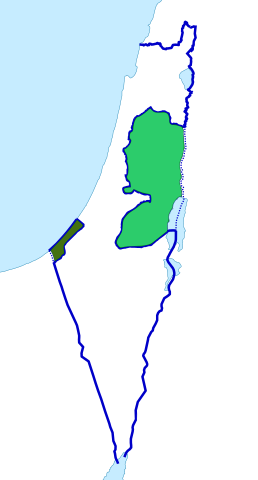 1949 armistice lines: The Jordanian-annexed West Bank (light green) and Egyptian client state All-Palestine Protectorate (dark green), after the 1948 Arab–Israeli War, showing 1949 armistice lines.
1949 armistice lines: The Jordanian-annexed West Bank (light green) and Egyptian client state All-Palestine Protectorate (dark green), after the 1948 Arab–Israeli War, showing 1949 armistice lines.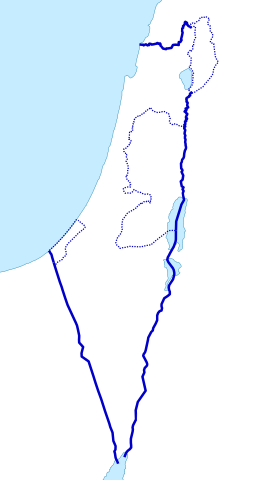 1967 territorial changes: During the Six-Day War, Israel captured the West Bank, the Gaza Strip, and the Golan Heights, together with the Sinai Peninsula (later traded for peace after the Yom Kippur War). In 1980–81 Israel annexed East Jerusalem and the Golan Heights.
Neither Israel's annexation nor the PLO claim over East Jerusalem gained international recognition.
1967 territorial changes: During the Six-Day War, Israel captured the West Bank, the Gaza Strip, and the Golan Heights, together with the Sinai Peninsula (later traded for peace after the Yom Kippur War). In 1980–81 Israel annexed East Jerusalem and the Golan Heights.
Neither Israel's annexation nor the PLO claim over East Jerusalem gained international recognition.
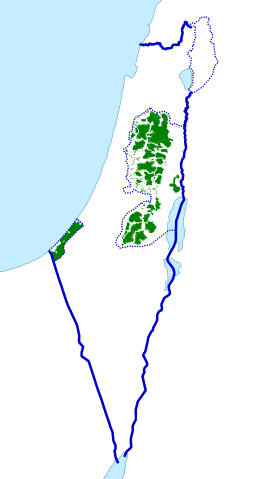 1995 Oslo II Accord: Under the Oslo Accords, the Palestinian National Authority was created to provide a Palestinian interim self-government in the West Bank and the interior of the Gaza Strip. Its second phase envisioned "Palestinian enclaves".
1995 Oslo II Accord: Under the Oslo Accords, the Palestinian National Authority was created to provide a Palestinian interim self-government in the West Bank and the interior of the Gaza Strip. Its second phase envisioned "Palestinian enclaves".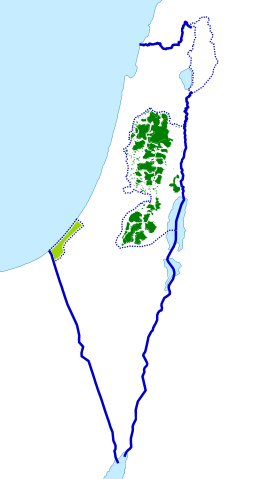 2005–present: After the Israeli disengagement from Gaza and clashes between the two main Palestinian parties following the Hamas electoral victory, two separate executive governments took control in the Palestinian territories of the West Bank and Gaza.
2005–present: After the Israeli disengagement from Gaza and clashes between the two main Palestinian parties following the Hamas electoral victory, two separate executive governments took control in the Palestinian territories of the West Bank and Gaza.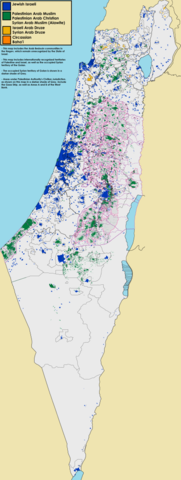 Ethnic majority by settlement (present): The map indicates the ethnic majority of settlements (cities, villages and other communities).
Ethnic majority by settlement (present): The map indicates the ethnic majority of settlements (cities, villages and other communities).
Boundaries
See also: Borders of Israel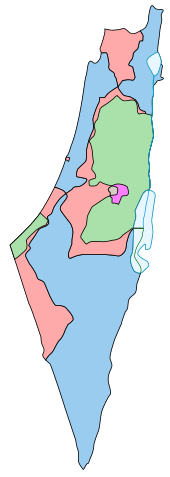
Boundaries defined in the 1947 UN Partition Plan for Palestine:
Area assigned for a Jewish state Area assigned for an Arab state Planned Corpus separatum with the intention that Jerusalem would be neither Jewish nor Arab
Armistice Demarcation Lines of 1949 (Green Line):
Israeli controlled territory from 1949 Egyptian and Jordanian controlled territory from 1948 until 1967
The Palestinian territories consist of two distinct areas: the West Bank (including East Jerusalem) and the Gaza Strip. Although the boundaries are commonly referred to as the "1967 borders", they are historically the armistice lines under the 1949 Armistice Agreements, which brought an end to the 1948 Arab–Israeli War, and are commonly referred to as the Green Line. The 1949 armistice lines were expressly declared to be armistice lines, and not international borders. Some Palestinian negotiators have claimed a return to those lines as the borders of a future Palestinian state, while Hamas does not recognize the State of Israel at all. The Arab League has supported these boundaries as the borders of the future State of Palestine in the 2002 Arab Peace Initiative.
The eastern limit of the West Bank is the border with Jordan. The Israel–Jordan peace treaty defined that border as the international border, and Jordan renounced all claims to territory west of it. The border segment between Jordan and the West Bank was left undefined pending a definitive agreement on the status of the territory.
The southern limit of the Gaza Strip is the border with Egypt. Egypt renounced all claims to land north of the international border, including the Gaza Strip, in the Egypt–Israel peace treaty. The Palestinians were not parties to either agreement.
The Gaza Strip is bounded by the Mediterranean Sea. The natural geographic boundary of the West Bank, as the name implies, is the Jordan River. To the Territories belong the territorial waters of the Gaza Strip and the part of the Dead Sea between the West Bank and the Jordan border-line (see adjacent CIA map), which are also completely controlled by Israel.
Palestinian state
Main article: State of Palestine See also: United Nations General Assembly resolution 67/19The Palestinian territories are part of the area intended by the United Nations to become the territory of the future State of Palestine. Originally, a larger area was allotted to the planned Palestinian state in Resolution 181 of 29 November 1947, but the Arabs rejected it and in the 1948 Palestine war, the Israeli army conquered major parts of it. While in the Partition Plan about 45% of historic Palestine was destined for the Arabic state, the Palestinian territories constitute only some 23%. The last figure is including all space occupied by Israeli settlements, walls, and roads.
In the UN, nearly all countries voted in favour of Resolution 58/292 of 17 May 2004; namely, that the boundaries of a future Palestinian state should be based on the pre-1967 borders, which correspond with the Green Line. The Resolution affirmed, in connection with the Palestinian right to self-determination and to sovereignty, that the independent State of Palestine should be based on the pre-1967 borders. In Resolution 43/177 of 15 December 1988, the declaration of independence of the State of Palestine was acknowledged by the UN General Assembly, but it was not admitted as a member state. In the same resolution, their sovereignty over the Occupied Palestinian Territory was recognized.
On 29 November 2012, the UN General Assembly passed United Nations General Assembly resolution 67/19 changing Palestine's observer status at the UN from "entity" to "non-member state" by a vote of 138 to 9, with 41 abstentions.
East Jerusalem
Main article: East Jerusalem See also: Status of Jerusalem
Immediately after the Six-Day War of June 1967, Israel effectively annexed East Jerusalem, an area comprising the much smaller prior Jordanian municipality of east Jerusalem and a surrounding area of the West Bank, as far as Kalandia to the north and Har Homa to the south. Israeli law, jurisdiction and administration were applied to this area, which was also made part of the Israeli Jerusalem municipality in its entirety. East Jerusalem residents became Israeli residents with blue Israeli ID cards. In 1980, the Knesset elevated the issue of the unity of Jerusalem to constitutional status by enacting Basic Law: Jerusalem the Capital of Israel, an act which was condemned by much of the world community, the few, mainly Latin American, embassies maintained in west Jerusalem promptly moving to Tel Aviv. Israel's annexation of East Jerusalem lacks international recognition by any country. Seven UNSC resolutions, including United Nations Security Council Resolution 478 declared it "null and void" and required that it be rescinded, stating that it was a violation of international law (the Fourth Geneva Convention). The United Nations never explicitly recognized Jerusalem as part of either Israel or Palestine, as Resolution 181 (1947) was never revoked. In Resolution 181, Jerusalem was intended to become a corpus separatum under international regime. Most countries do not recognize either West Jerusalem or Jerusalem as Israel's capital.
Palestinians regard East Jerusalem as the capital of the future Palestinian state. East Jerusalem is generally recognized as part of the Palestinian Territories. In UN resolutions concerning Israel, East Jerusalem is routinely referred to as a part of the Occupied Palestinian Territory.
According to the Israeli Supreme Court, the Fourth Geneva Convention, which prohibits unilateral annexation of occupied territory, does not apply to East Jerusalem, as there was no "legitimate sovereign" recognised by Israel and its allies previously exercising control over the territory. In Israel, there has always been large support for retaining all of Jerusalem under Israeli sovereignty, although opinions differ regarding the large number of outlying Palestinian villages and neighbourhoods annexed to Jerusalem beyond "core" East Jerusalem (the Old City, Sheikh Jarrah and the large post-1967 Jewish neighborhoods such as Ramot, Ramat Eshkol, French Hill and Gilo).
A few times, there were Israeli or U.S. proposals to divide East Jerusalem between Israel and the Palestinians. In the 1995 Beilin–Abu Mazen agreement, Israeli negotiators proposed Palestinian sovereignty over some Arab neighborhoods within an expanded Jerusalem that would include annexed Israeli neighborhoods and major settlement blocs. In 2000, U.S. president Bill Clinton offered a similar proposal in his Clinton Parameters. In more recent years, the Israeli position has strongly been favourable to keeping all of Jerusalem under Israeli sovereignty.
Gaza Strip
Main article: Gaza StripIn 2005, Israel pulled all its remaining forces out of the Gaza Strip and dismantled its settlements. Nevertheless, according to the international community, the Gaza Strip is still considered to be occupied by Israel. Israel has denied that it occupies the Gaza Strip, but two of the three border sectors of the Gaza Strip, together with the coast and airspace, are controlled by Israel (the third border sector near Rafah is controlled by Egypt). The UN Special Rapporteur on the situation of human rights in the Palestinian territories occupied since 1967 stated in 2007:
Israel remains an occupying Power in respect of Gaza. Arguments that Israel ceased its occupation of Gaza in 2005 following the evacuation of its settlements and the withdrawal of its troops take no account of the fact that Israel retains effective control over Gaza by means of its control over Gaza's external borders, airspace, territorial waters, population registry, tax revenues and governmental functions. The effectiveness of this control is emphasized by regular military incursions and rocket attacks.
Administrative divisions
The Constitution of the League of Arab States says the existence and independence of Palestine cannot be questioned de jure even though the outward signs of this independence have remained veiled as a result of force majeure. The League supervised the Egyptian trusteeship of the Palestinian government in Gaza after the termination of the British Mandate and secured assurances from Jordan that the 1950 Act of Union was "without prejudice to the final settlement".
By the 1988 declaration, the PNC empowered its central council to form a government-in-exile when appropriate, and called upon its executive committee to perform the duties of the government-in-exile until its establishment.
Under the terms of the Oslo Accords signed between Israel and the PLO, the latter assumed control over the Jericho area of the West Bank and the Gaza Strip on 17 May 1994. On 28 September 1995, following the signing of the Israeli–Palestinian Interim Agreement on the West Bank and Gaza Strip, Israeli military forces withdrew from the West Bank towns of Nablus, Ramallah, Jericho, Jenin, Tulkarem, Qalqilya and Bethlehem. In December 1995, the PLO also assumed responsibility for civil administration in 17 areas in Hebron. While the PLO assumed these responsibilities as a result of Oslo, a new temporary interim administrative body was set up as a result of the Accords to carry out these functions on the ground: the Palestinian National Authority (PNA).
An analysis outlining the relationship between the PLO, the PNA (PA), Palestine and Israel in light of the interim arrangements set out in the Oslo Accords begins by stating that, "Palestine may best be described as a transitional association between the PA and the PLO." It goes on to explain that this transitional association accords the PA responsibility for local government and the PLO responsibility for representation of the Palestinian people in the international arena, while prohibiting it from concluding international agreements that affect the status of the occupied territories. This situation is said to be accepted by the Palestinian population insofar as it is viewed as a temporary arrangement.
Since the Battle of Gaza (2007), the two separate territories, the Gaza Strip and the West Bank, are divided into a Hamas leadership in the Gaza Strip and a Fatah civil leadership in the autonomous areas of the West Bank. Each sees itself as the administrator of all Palestinian Territories and does not acknowledge the other one as the official government of the territories. The Palestinian Territories have therefore de facto split into two entities.

Governorates
Main article: Governorates of the Palestinian National AuthorityAfter the signing of the Oslo Accords, the Palestinian territories were divided 16 governorates under the jurisdiction of the Palestinian National Authority. Since 2007 there are two governments claiming to be the legitimate government of the Palestinian National Authority, one based in the West Bank and one based in the Gaza Strip.
West Bank Areas
Main article: West Bank Areas in the Oslo II Accord
The Oslo II Accord created three temporary distinct administrative divisions in the Palestinian territories, the Areas A, B and C, until a final status accord would be established. The areas are not contiguous, but rather fragmented depending on the different population areas as well as Israeli military requirements.
- Area A (full civil and security control by the Palestinian Authority): circa 3% of the West Bank, exclusive East-Jerusalem (first phase, 1995). In 2011: 18%. This area includes all Palestinian cities and their surrounding areas, with no Israeli settlements. Entry into this area is forbidden to all Israeli citizens. The Israel Defense Forces occasionally enters the area to conduct raids to arrest suspected militants.
- Area B (Palestinian civil control and joint Israeli–Palestinian security control): circa 25% (first phase, 1995). In 2011: 21%. Includes areas of many Palestinian towns and villages and areas, with no Israeli settlements.
- Area C (full Israeli civil and security control, except over Palestinian civilians): circa 72% (first phase, 1995). In 2011: 61%. These areas include all Israeli settlements (cities, towns, and villages), nearby land, most roadways that connected the settlements (and which Israelis are now restricted to) as well as strategic areas described as "security zones." There were 1,000 Israeli settlers living in Area C in 1972. By 1993, their population had increased to 110,000. As of 2012 they number more than 300,000 – as against 150,000 Palestinians, the majority of whom are Bedouin and fellahin.
Governance
Palestinian National Authority and Governance of the Gaza StripThe political status of the territories has been the subject of negotiations between Israel and the PLO and of numerous statements and resolutions by the United Nations. (See List of United Nations resolutions concerning Israel.) Since 1994, the autonomous Palestinian National Authority has exercised various degrees of control in large parts of the territories, as a result of the Declaration of Principles contained in the Oslo Accords. The United States government considers the West Bank and Gaza as a single entity for political, economic, legal and other purposes.
The State Department and other U.S. government agencies, such as USAID West Bank and Gaza, have been tasked with projects in the areas of democracy, governance, resources, and infrastructure. Part of the USAID mission is to provide flexible and discrete support for implementation of the Quartet Road Map. The Road Map is an internationally backed plan that calls for the progressive development of a viable Palestinian State in the West Bank and Gaza. Participating states provide assistance through direct contributions or through the Palestinian State account established by the World Bank.

Hamas won a majority of seats in elections for the Palestinian Parliament in 2006 and formed a government in Ramallah for the entire PA largely shunned by the United States and Israel. The Fatah movement continued to dominate the PA security forces in both the West Bank and Gaza Strip. In 2007, Hamas took control of the Gaza Strip by force, executing PA officers and removing its officials, many of whom, such as Muhammad Dahlan, escaped the Gaza Strip with their families.
Mahmoud Abbas promptly deposed the Hamas-dominated PA government, and two rival administrations were created, a Fatah-controlled one in the West Bank, with which Israel, the US and the EU resumed business, and a Hamas-controlled one in the Gaza Strip which was largely shunned by the world community. After Hamas intensified rocket and mortar fire on Israeli civilian centers from the Gaza Strip, the United States and Israel instituted a military and economic blockade of the Gaza Strip. When that failed to topple the new government, a covert operation was launched to eliminate Hamas by force. The covert initiative was exposed when confidential State Department documents were accidentally leaked by the U.S. envoy. The talking points delivered to the Fatah leadership said:
Hamas should be given a clear choice, with a clear deadline: they either accept a new government that meets the Quartet principles, or they reject it. The consequences of Hamas' decision should also be clear: If Hamas does not agree within the prescribed time, you should make clear your intention to declare a state of emergency and form an emergency government explicitly committed to that platform.
Since the Battle of Gaza (2007), the administration of the territories has been contested by two rival factions of the Palestinian National Authority, with Hamas controlling the Gaza Strip and Fatah continuing to administer the West Bank. Both groups claim legitimacy over leadership of the Palestinian territories. Most countries with an interest in the issues, including most of the Arab countries, recognize the administration of Mahmoud Abbas as the legitimate government over both Palestinian Territories.
During Operation Cast Lead the UN Security Council adopted Resolution 1860 (2009), which said that the Gaza Strip constitutes an integral part of the territory occupied in 1967 that will be a part of the Palestinian state.
On 15 December 2011, Iceland recognized Palestine as an independent and sovereign state within the pre-1967 Six-Day War borders; Össur Skarphéðinsson, Minister for Foreign Affairs of Iceland, and Dr. Riad Malki, the Foreign Minister of Palestine, formally confirmed the establishment of full diplomatic relations between Iceland and Palestine.
The 2014 Fatah–Hamas Gaza Agreement provided for elections and the formation of a compromise unity government. The 2014 Israel–Gaza conflict intervened, however the unity government survived. In August, Palestinian leaders said they would apply to the United Nations Security Council for the establishment of a timetable for ending the Israeli occupation in the West Bank. The application would be made on 15 September 2014, following an Arab League meeting on 5 September at which support for the move would be requested. Unless a timetable was established, the Palestinian leadership said it would apply to the International Criminal Court where it would hold Israel responsible for its actions not only in the West Bank, but in the Gaza Strip.
Political status and sovereignty
See also: International law and the Arab–Israeli conflict and Status of territories occupied by Israel in 1967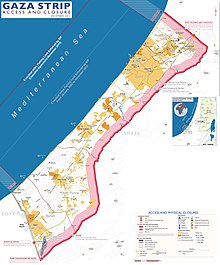

The international community regards the Palestinian territories, meaning the West Bank including East Jerusalem and the Gaza Strip, as territories occupied by Israel. Israel has withdrawn its military forces from the Gaza strip, but it continues to be designated the occupying power in the Gaza Strip by the United Nations, the United States and various human rights organizations. The final status of the Palestinian Territories as an independent state is supported by the countries that form the Quartet's "Road map for peace". The government of Israel has also accepted the road map but with 14 reservations.
A transfer of powers and responsibilities for the Gaza Strip and Jericho took place pursuant to the Israel–PLO 4 May 1994 Cairo Agreement on the Gaza Strip and the Jericho Area. In other areas of the West Bank, transfer of powers took place pursuant to the Israel–PLO 28 September 1995 Interim Agreement, the Israel–PLO 15 January 1997 Protocol Concerning the Redeployment in Hebron, the Israel–PLO 23 October 1998 Wye River Memorandum, and the 4 September 1999 Sharm el-Sheikh Agreement.
The DOP provides that Israel will retain responsibility during the transitional period for external security and for internal security and public order of Israeli settlements and citizens. Direct negotiations to determine the permanent status of Gaza and the West Bank had begun in September 1999 after a three-year hiatus, but have been derailed by the al-Aqsa Intifada that began in September 2000.
In 2003, the Israeli government issued a plan for total withdrawal from the Gaza Strip and part of the northern West Bank by late 2005. This became known as the Disengagement Plan. The Palestinian Authority welcomed this plan, but declared that until final status, it would still consider the Gaza Strip under Israeli occupation. Many Israelis opposed the plan, and tensions were very high in Israel before and after the Disengagement Plan was approved by the Israeli Knesset on 16 February 2005.
In August 2005, the Israel Defense Forces and Israeli police forcibly removed all settlers from the Gaza Strip. Israel completed the disengagement on 12 September 2005. Presently, most of the West Bank is administered by Israel though 42% of it is under varying degrees of autonomous rule by the Fatah-run Palestinian Authority. The Gaza Strip is currently under the control of Hamas.
The International Criminal Court (ICC) is an independent international treaty organisation with its own legislative assembly. Many of the member states recognise the State of Palestine. The Palestinian Foreign Minister Riad al-Malki presented the ICC prosecutor with documentary evidence which shows that 67 states in Latin America, Asia, Africa, and Europe have legally recognised the State of Palestine.
In January 2010, King Abdullah of Jordan, after a meeting with the Israeli president Shimon Peres at the World Economic Forum in Davos, declared that his country does not want to rule the West Bank and that "the two-state solution" to the Israeli–Palestinian conflict was the only viable option. If rule over the territory was to be transferred to the kingdom, it would only "replace Israeli military rule with Jordanian military rule... and the Palestinians want their own state".
On Thursday, 29 November 2012, In a 138–9 vote (with 41 abstaining) General Assembly resolution 67/19 passed, upgrading Palestine to "non-member observer state" status in the United Nations. The new status equates Palestine's with that of the Holy See. The change in status was described by The Independent as "de facto recognition of the sovereign state of Palestine". The vote was a historic benchmark for the partially recognised State of Palestine and its citizens, whilst it was a diplomatic setback for Israel and the United States. Status as an observer state in the UN will allow the State of Palestine to join treaties and specialised UN agencies, including the International Civil Aviation Organisation, the International Criminal Court, and other organisations for recognised sovereign nations. It shall permit Palestine to claim legal rights over its territorial waters and air space as a sovereign state recognised by the UN, and allow the Palestinian people the right to sue for control of their claimed territory in the International Court of Justice and to bring war-crimes charges against Israel in the International Criminal Court.

Customary international law, including the International Court of Justice's interpretation of the Fourth Geneva Convention in their July 2004 ruling, has been widely interpreted as prohibiting Israel from building settlements, due to its clauses prohibiting the transfer of a civilian population into an occupied territory. This was reaffirmed 5 December 2001, at the Conference of High Contracting Parties to the Fourth Geneva Convention. The participating High Contracting Parties called upon Israel "to fully and effectively respect the Fourth Geneva Convention in the Occupied Palestinian Territory, including East Jerusalem, and to refrain from perpetrating any violation of the Convention. They reaffirm the illegality of the settlements in the said territories and of the extension thereof."
Article 47 of the Fourth Geneva Convention prohibits any change of status in occupied territory concluded through negotiations between the occupying power and local authorities under occupation. This finding also suggests that Israel may be in violation of the Rome Statute (one of the primary legal instruments of the International Criminal Court), Article 8, section (2)(b)(viii): "The transfer, directly or indirectly, by the Occupying Power of parts of its own civilian population into the territory it occupies, or the deportation or transfer of all or parts of the population of the occupied territory within or outside this territory" see:.
Given that United Nations General Assembly resolution 67/19 upgraded Palestine to non-member observer state status in November 2012, representatives of Palestine may now be able to take members of the Israeli government to the International Criminal Court under violations of the Rome Statute. On 31 January 2012, the United Nations independent "International Fact-Finding Mission on Israeli Settlements in the Occupied Palestinian Territory" filed a report stating that if Israel did not stop all settlement activity immediately and begin withdrawing all settlers from the West Bank, it potentially might face a case at the International Criminal Court, increasing credibility of any Palestinianin attempt to do so.
The UN has, after granting Palestine observer state status, permitted Palestine to title its representative office to the UN as 'The Permanent Observer Mission of the State of Palestine to the United Nations', seen by many as a reflexion of the UN's de facto recognition of the State of Palestine's sovereignty, and Palestine has started to re-title its name accordingly on postal stamps, official documents and passports. The Palestinian authorities have also instructed its diplomats to officially represent 'The State of Palestine', as opposed to the 'Palestine National Authority'. Additionally, on 17 December 2012, UN Chief of Protocol Yeocheol Yoon decided that 'the designation of "State of Palestine" shall be used by the Secretariat in all official United Nations documents'.

Critics point out that implementation of the Oslo Accords has not improved conditions for the population under occupation. In 2009, the UN considered the West Bank and the Gaza Strip to still be occupied by Israel. Israel's policies and actions in its ongoing occupation of the Palestinian territories have drawn accusations that it is committing the crime of apartheid.
Israel contends that the settlements are not illegal as the West Bank is considered a "disputed territory" under international law. United Nations Security Council Resolution 242 recognized Israel's rights to "safe and secure borders", which has been interpreted by the Israeli government as meaning that Israel had a right to West Bank territory for secure borders. The San Remo Conference, binding under international law, further envisioned the West Bank as being part of a sovereign Jewish state, and arguably encourages, rather than prohibits Jewish settlement in the area. Furthermore, according to the Israeli government, many of the settlements were established on the sites of former Jewish communities that had existed there prior to 1947 on land that was legitimately bought, and ethnically cleansed by Arab forces. Israel views the territory as being the subject of legitimate diplomatic dispute and negotiation under international law.
East Jerusalem, captured in 1967, was unilaterally annexed by Israel. The UN Security Council Resolution 478 condemned the annexation as "a violation of international law". This annexation has not been recognized by other nations, although the United States Congress declared its intention to recognize the annexation (a proposal that has been condemned by other states and organizations). Because of the question of Jerusalem's status, most states base their diplomatic missions there and treat Tel Aviv as the capital, though the United States and Guatemala both have embassies in the Jerusalem. Israel asserts that these territories are not currently claimed by any other state and that Israel has the right to control them.

Israel's position has not been accepted by most countries and international bodies, and the West Bank (including East Jerusalem) and the Gaza Strip are referred to as occupied territories (with Israel as the occupying power) by most international legal and political bodies, the rest of the Arab bloc, the UK, including the EU, the United States (before President Trump), both the General Assembly and Security Council of the United Nations, the International Court of Justice, the Conference of High Contracting Parties to the Fourth Geneva Convention, and the Israeli Supreme Court (in a decision regarding the Israeli West Bank barrier).
Former U.S. President George W. Bush stated, during his presidency, that he did not expect Israel to return entirely to pre-1967 borders, due to "new realities on the ground."
Both US President Bill Clinton and UK Prime Minister Tony Blair, who played notable roles in attempts at mediation, noted the need for some territorial and diplomatic compromise on this issue, based on the validity of some of the claims of both sides. One compromise offered by Clinton would have allowed Israel to keep some settlements in the West Bank, especially those in large blocks near the pre-1967 borders of Israel. In return, Palestinians would have received concessions of land in other parts of the country. The United Nations did not declare any change in the status of the territories as of the creation of the Palestinian National Authority between 1993 and 2000, although a 1999 U.N. document implied that the chance for a change in that status was slim at that period.
During the period between the 1993 Oslo Accords and the Second Intifada beginning in 2000, Israeli officials asserted that the term "occupation" did not accurately reflect the state of affairs in the territories. During this time, the Palestinian population in large parts of the territories had a large degree of autonomy and only limited exposure to the IDF except when seeking to move between different areas. Following the events of the Second Intifada, and in particular, Operation Defensive Shield, most territories, including Palestinian cities (Area A), came back under effective Israeli military control, making the discussion along those lines largely moot.
In the summer of 2005, Israel implemented its unilateral disengagement plan; about 8,500 Israeli citizens living in the Gaza Strip were forcibly removed from the territory, along with citizens from 4 settlements in the northern West Bank; some were compensated with alternative homes and a sum of money. The Israel Defense Forces vacated Gaza in 2005, but invaded it again in 2006 in response to rocket attacks and the abduction of Israeli soldier Gilad Shalit by Hamas.
In January 2010, King Abdullah of Jordan, after a meeting with the Israeli president Shimon Peres at the World Economic Forum in Davos, declared that his country does not want to rule the West Bank and that "the two-state solution" to the Israeli–Palestinian conflict was the only viable option. If rule over the territory was to be transferred to the kingdom, it would only "replace Israeli military rule with Jordanian military rule... and the Palestinians want their own state."
In December 2010, Brazil recognized Palestine as a state with its 1967 borders. This move was later followed by Argentina, Peru, Uruguay, Bolivia and Ecuador. This action was later criticized by Israel and the United States, who labelled it "counterproductive".
Old and gas
Occupied Palestinian Territories is believed to possess substantial oil and gas deposits. More than 3 billion barrels (480,000,000 m) of oil are thought to lie beneath Occupied Palestinian Territories and off the coastline. Within the Levant Basin alone, about 1.7 billion barrels (270,000,000 m) have been identified, with an additional 1.5 billion barrels (240,000,000 m) underneath the occupied West Bank. Around 2 billion barrels (320,000,000 m) of reserves are also believed to be located off the shore of the Gaza Strip.
A UNCTAD report indicates that the West Bank, likely encompassing the Meged oil field, contains approximately 1,250 billion barrels (1.99×10 m) of oil. According to the Palestinian Authority, 80% of this field lies on land owned by Palestinians.
Masadder, a subsidiary of the Palestine Investment Fund, is leading efforts to develop the oilfield in the West Bank.
Demographics
Main articles: Demographics of the State of Palestine and PalestiniansThe Palestinian Central Bureau of Statistics (PCBS) estimated Palestinians at mid year 2009 as 10.7 million persons as follows: 3.9 million in the Palestinian Territory (36.6%), 1.2 million (11.5%) in Israel; 5.0 million in Arab countries (46.2%), 0.6 million in foreign countries (5.7%).
According to The Guardian (2008), the Palestinian territories have one of the fastest growing populations in the world, with numbers surging 30% in the past decade (2008). There were 3.76 million Palestinians in the West Bank and the Gaza Strip, up from 2.89 million ten years earlier.
According to the U.S. Census, population growth from 1990 to 2008 in Gaza and the West Bank was 106%, from 1.9 million (1990) to 3.9 million persons.
According to the UN (2010), the Palestinian population was 4.4 million. According to the Palestinian Central Bureau of Statistics (PCBS) population density in 2009 was 654 capita/km, of which 433 capita/km in the West Bank including Jerusalem and 4,073 capita/km in Gaza Strip. In mid-2009, the share of population less than 15 years was 41.9% and above 65 years 3%.
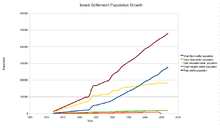
In the 1970s, Israel's methods for seizing Palestinian land to establish settlements included requisitioning for ostensibly military purposes and spraying of land with poison.
The PCBS estimated that about 564,000 Israeli settlers lived in the West Bank in 2012. Some 203,000 of them were settled in East Jerusalem (Area J1 of the Jerusalem Governorate) and 346,000 in the remaining West Bank.
Consistent with its policy of Jerusalem as a united and indivisible capital of Israel, Israel does not publish exact figures of the number of settlers in East Jerusalem. Rather the figures of Israelis in Judea and Samaria District are given. Independently from the political composition of its subsequent governments, the number of settlers in the West Bank has grown rapidly and in a relatively straight line since 1967 (see graphics). The Israeli Central Bureau of Statistics counted about 341,000 settlers end 2012 in the Judea and Samaria District, which does not include Jerusalem.
Population
Main articles: List of cities in Palestine, List of cities administered by the Palestinian Authority, and List of cities in the Gaza Strip| Population (mid year) | |||
|---|---|---|---|
| Year | West Bank | Gaza | Total |
| 1970 | 0.69 | 0.34 | 1.03 |
| 1980 | 0.90 | 0.46 | 1.36 |
| 1990 | 1.25 | 0.65 | 1.90 |
| 2000 | 1.98 | 1.13 | 3.11 |
| 2004 | 2.20 | 1.30 | 3.50 |
| 2008 | 2.41 | 1.5 | 3.91 |
| 2010 | 2.52 | 1.60 | 4.12 |
| Source: U.S. Census Bureau | |||
| 2006 | 2.5 | 1.5 | 4.0 |
| 2009 | 2.48 | 1.45 | 3.94 |
| Source: Palestinian Central Bureau of Statistics | |||
| Region | Population |
|---|---|
| West Bank | 2,568,555 |
| East Jerusalem | 192,800 |
| Gaza Strip | 1,657,155 |
| Name | Population (2007) |
Area (km) | Density |
|---|---|---|---|
| West Bank | 2,369,700 | 5,671 | 417.86 |
| Gaza Strip | 1,416,539 | 360 | 3934.83 |
| Total | 3,786,239 | 6,031 | 627.80 |
Religion
The overwhelming majority of Palestinians are Muslims. Almost the entire Palestinian Muslim population is Sunni, although few dozen converts to Ahmadiyya Islam resides in West Bank. According to Palestinian constitution, article 4: "Islam is the official religion of Palestine. Respect for the sanctity of all other divine religions shall be maintained".
Christians constitute about 1–2% of population of Palestinian territories. The Christian population of Gaza is estimated at 3,000. There are about 370 Samaritans in West Bank village of Kiryat Luza on Mount Gerizim who hold both Palestinian and Israeli citizenship. The number of Jewish settlers in West Bank is estimated at 341,000 as of the end of 2012 and over 200,000 in East Jerusalem. The Jericho Synagogue, located in the city of Jericho, stands as the sole synagogue in Palestine.
Language
Arabic is the official language in the State of Palestine. Palestinian Arabic is the vernacular. Hebrew and English are widely spoken. 16.1% of the population are Israeli settlers who mostly speak Hebrew as their native language, and Hebrew is a second or third language to many Palestinians.
See also
- Outline of the State of Palestine
- History of Palestinian journalism
- Coordinator of Government Activities in the Territories
- Economy of the State of Palestine
- Healthcare in the State of Palestine
- Judea and Samaria Area
- Legality of the Israeli occupation of Palestine
- Palestinian Environmental NGOs Network
- Racism in the State of Palestine
- Tourism in the State of Palestine
- Water, Sanitation and Hygiene Monitoring Program
- Water supply and sanitation in the State of Palestine
Notes
- Israeli documentation provides population figures for the whole of Jerusalem without specific information on East Jerusalem being provided.
References
- ^ "CIA – The World Factbook". Central Intelligence Agency. Retrieved 28 November 2012.
- "CIA – The World Factbook". Central Intelligence Agency. Retrieved 28 November 2012.
- ^ "Estimated Population in the Palestinian Territory Mid-Year by Governorate, 1997–2016". State of Palestine Central Bureau of Statistics. Archived from the original on 8 June 2014. Retrieved 20 April 2023.
- ^ "Palestinian Central Bureau of Statistics (PCBS). On the Eve of International Population Day 11/7/2009" (PDF). pcbs.gov.ps. Archived from the original (PDF) on 20 January 2017. Retrieved 20 April 2023.
- ^ Israeli Settlements in Palestine—Annual Statistical Report 2012 Archived 15 November 2014 at the Wayback Machine, Table 2, p. 48. Palestinian Central Bureau of Statistics, August 2013
- "Human Development Reports" (PDF). Human Development Reports. Archived from the original (PDF) on 15 November 2011. Retrieved 10 June 2016.
- "Archived copy" (PDF). Archived from the original (PDF) on 6 July 2010. Retrieved 6 July 2010.
{{cite web}}: CS1 maint: archived copy as title (link) "International Court of Justice Reports of Judgments, Advisory Opinions and Orders – Legal Consequences of the Construction of a Wall in the Occupied Palestinian Territory Advisory Opinion of 9 July 2004 ". Retrieved 11 August 2013 - Ben-Naftali, Orna; Gross, Aeyel M.; Michaeli, Keren (2005). "Illegal Occupation:Framing the Occupied Palestinian Territory". Berkeley Journal of International Law. 23 (3): 552. Archived from the original on 7 February 2017. Retrieved 9 October 2018.
"gradually substituting the terms....Palestinian occupied territories
- International Court of Justice (19 July 2024). "Legal Consequences arising from the Policies and Practices of Israel in the Occupied Palestinian Territory, including East Jerusalem" (PDF). International Court of Justice. Retrieved 19 July 2024.
- "ISO 3166-1 Newsletter No. V-2" (PDF). International Organization for Standardization. 1 October 1999. Archived from the original (PDF) on 22 July 2011.
- Le More, Anne (2008). International assistance to the Palestinians after Oslo: political guilt, wasted money. Routledge studies on the Arab-Israeli conflict. Vol. 1. London and New York: Routledge. p. 27. ISBN 978-0-415-45385-1.
- ^ "December Overview" (PDF). UNOCHA. December 2009. Archived from the original (PDF) on 16 February 2010. Retrieved 3 January 2010.
- "Israeli practices affecting the human rights of the Palestinian people in the Occupied Palestinian Territory, including East Jerusalem: Report of the Secretary-General (UN Doc. A/71/364)". United Nations. 30 August 2016. Retrieved 29 November 2016.
- Le More, Anne (2008). International assistance to the Palestinians after Oslo: political guilt, wasted money. Routledge studies on the Arab-Israeli conflict. Vol. 1. London and New York: Routledge. p. 29. ISBN 978-0-415-45385-1.
- "Settlement Expansion in Occupied Palestinian Territory Violates International Law, Must Cease, Many Delegates Tell Security Council | Meetings Coverage and Press Releases". press.un.org. 27 September 2023. Retrieved 22 August 2024.
- "Occupied Palestinian Territory | OCHA". www.unocha.org. 21 August 2024. Retrieved 22 August 2024.
- "United Nations Office for the Coordination of Humanitarian Affairs - occupied Palestinian territory | Home Page". United Nations Office for the Coordination of Humanitarian Affairs - occupied Palestinian territory. Retrieved 22 August 2024.
- "European Union, Trade in goods with Occupied Palestinian Territory" (PDF). European Commission / Directorate-General for Trade. 4 November 2016. Archived (PDF) from the original on 28 May 2019. Retrieved 29 November 2016.
- "Council conclusions on the Middle East Peace Process". Council of the European Union. 18 January 2016. Retrieved 29 November 2016.
The Council highlights the importance of unhindered work of civil society both in Israel and the occupied Palestinian territory and follows recent developments in this regard with concern.
- "Occupied Territories or Disputed Territories?". Jerusalem Center for Public Affairs. Retrieved 27 June 2023.
- Jonathan Kuttab; Claude Klein (2000). "5. Access to Jerusalem and the Holy Places". Jerusalem:Points Beyond Friction and Beyond. Kluwer Law International. p. 68. ISBN 9041188436.
- Barahona, Ana (2013). Bearing Witness – Eight weeks in Palestine. London: Metete. p. 12. ISBN 978-1-908099-02-0.
- "United Nations Position on Jerusalem Unchanged, Special Coordinator Stresses, as Security Council Debates United States Recognition of City | Meetings Coverage and Press Releases". press.un.org. Archived from the original on 30 May 2024. Retrieved 6 July 2024.
- Resolution 446, Resolution 465, Resolution 484, among others
- "Legal Consequences of the Construction of a Wall in the Occupied Palestinian Territory". International Court of Justice. 9 July 2004. Archived from the original on 28 August 2007. Retrieved 27 September 2006.
- "Conference of High Contracting Parties to the Fourth Geneva Convention: statement by the International Committee of the Red Cross". International Committee of the Red Cross. 5 December 2001. Archived from the original on 7 February 2011. Retrieved 27 September 2006.
- "Applicability of the Geneva Convention relative to the Protection of Civilian Persons in Time of War, of 12 August 1949, to the Occupied Palestinian Territory, including Jerusalem, and the other occupied Arab territories". United Nations. 17 December 2003. Archived from the original on 3 June 2007. Retrieved 27 September 2006.
- "EU-Settlements Watch" (PDF). 1 February – 31 July 2002. Archived (PDF) from the original on 7 September 2009.
- Shlomo Slonim, Jerusalem in America's Foreign Policy: 1947–1997, Martinus Nijhoff Publishers, 1998 pp.332–333.
- Menachem Klein, C. Hurst & Co. Publishers, 2001 pp.189ff., passim.
- Korman, Sharon (31 October 1996). The Right of Conquest: The Acquisition of Territory by Force in International Law and Practice. Clarendon Press. ISBN 9780191583803 – via Google Books.
- Dugard, John (1987). Recognition and the United Nations. Cambridge: Grotius Publications Limited. pp. 111–115. ISBN 0-521-46322-X.
- 'Occupation costs Palestinians 'billions',' Al Jazeera, 9 October 2013
- 'Cost of occupation – over $50 billion,' Ynet, 9 June 2007
- Human Rights Watch, 1 February 2010; Stateless Again – II. International and Jordanian Law
- 'Gaza in 2020: A liveable place?', UNRWA, August 2012
- 'Humanitarian Fact Sheet on the Jordan Valley and the Dead Sea Area,' Archived 7 November 2012 at the Wayback Machine OCHA, February 2012.
- "Hamas leader's Tunisia visit angers Palestinian officials". Al Arabiya. 7 January 2012. Retrieved 26 December 2012.
- O'Brien, Patricia (21 December 2012). "Issues related to General assembly resolution 67/19 on the status of Palestine in the United nations" (PDF). United Nations. Archived (PDF) from the original on 31 March 2016. Retrieved 9 October 2018.
- Gharib, Ali (20 December 2012). "U.N. Adds New Name: "State of Palestine"". The Daily Beast. Archived from the original on 1 January 2013. Retrieved 10 January 2013.
- "Name change for State of Palestine and other minor corrections" (PDF). International Organization for Standardization. 3 November 2013. Archived from the original (PDF) on 3 November 2013.
- McHigh, Jess (19 August 2015). "Israel-Palestine Conflict: French UN Security Council Resolution Off The Table in Favor of Palestinian Statehood?". International Business Times. Retrieved 22 October 2015.
- United Nations. "UN Charter". United Nations. Archived from the original on 26 September 2011. Retrieved 21 November 2014.
- FAQ: The Peace process with the Palestinians – Dec 2009. Mfa.gov.il. Retrieved 2012-01-15.
- From "Occupied Territories" to "Disputed Territories," by Dore Gold Archived 9 July 2011 at the Wayback Machine. Jcpa.org. Retrieved 2012-01-15.
- ^ Keinon, Herb. "Politics: Fatah-Hamas unity talks breed Likud harmony". The Jerusalem Post. Retrieved 21 June 2014.
- ^ "Set 'timetable' to end Israeli occupation, Palestine to UN". Arab Herald. 28 August 2014. Retrieved 28 August 2014.
- "The occupied Palestinian territories: Dignity Denied". International Committee of the Red Cross. 13 December 2007. Retrieved 26 December 2012.
- "UK and The Occupied Palestinian Territories". GOV.UK. Retrieved 29 November 2016.
- "House of Commons International Development Committee – FINAL REPORT Vol I 26 January 2004" (PDF). Archived (PDF) from the original on 9 February 2004. Retrieved 30 June 2010.
- Julie Peteet (2005) Words as interventions: naming in the Palestine–Israel conflict, Third World Quarterly, 26:1, 153–172, doi:10.1080/0143659042000322964
- Joseph Gorny; Yosef Gorni (1983). The British labour movement and Zionism, 1917–1948. Routledge. p. 138. ISBN 978-0-7146-3162-2.
The Jewish people have always regarded, and will continue to regard Palestine as a whole, as a single country which is theirs in a national sense and will become theirs once again. No Jew will accept partition as a just and rightful solution.
- Shlaim, Avi (2008). The Iron Wall: Israel and the Arab World. Paw Prints. p. 670. ISBN 978-1-4352-9513-1.
- See, for example, Open a Bible
- The Likud—Platform states "The Government of Israel flatly rejects the establishment of a Palestinian Arab state west of the Jordan River. The Palestinians can run their lives freely in the framework of self-rule, but not as an independent and sovereign state."
- History, Civil Society Network on the Question of Palestine, Division for Palestinian Rights, United Nations. Archived 4 September 2009 at the Wayback Machine
- Mark A. Tessler, A History of the Israeli-Palestinian conflict. page 211
- s:Cablegram from the Secretary-General of the League of Arab States to the Secretary-General of the United Nations
- Announcement in the UK House of Commons of the recognition of the State of Israel and also of the annexation of the West Bank by the State of Jordan. Commons Debates (Hansard) 5th series, Vol 474, pp1137-1141. 27 April 1950. scan (PDF)
- Palestinian National Charter Archived 17 December 2000 at the Wayback Machine, 1964
- "Khartoum Resolutions". Mideastweb.org. 19 June 1967. Retrieved 30 June 2010.
- ^ "United Nations – Office of Legal Affairs" (PDF). United Nations. Archived from the original on 28 September 2011.
- ^ Resolution 58/292. Status of the Occupied Palestinian Territory, including East Jerusalem Archived 6 August 2012 at the Wayback Machine; 17 May 2004 (doc.nr. A/RES/58/292)
- Based on figures of the CIA World Factbook. The Factbook estimates the land area of Israel (excluding the Golan Heights) 20,330 square kilometer, the West Bank (including East Jerusalem, but excluding Mt. Scopus) 5,640 and the Gaza Strip 360.
- UNGA; Resolution 43/177. Question of Palestine Archived 1 November 2011 at the Wayback Machine (doc.nr. A/RES/43/177)
- "Palestinians win implicit U.N. recognition of sovereign state". Reuters. 29 November 2012. Retrieved 29 November 2012.
- "UN makes Palestine nonmember state". 3 News NZ. 30 November 2012. Archived from the original on 16 January 2013. Retrieved 29 November 2012.
- "The Status of Jerusalem in International and Israeli Law". Jerusalem Center for Public Affairs. 2018. Retrieved 20 May 2019.
- "Palestinians accuse Romney of 'racist' remark". Al Jazeera. 31 July 2012. Retrieved 26 December 2012.
- "Romney calling Jerusalem Israel's capital is 'unacceptable,' says Erekat". Haaretz. Associated Press. 30 July 2012. Retrieved 26 December 2012.
- "Israel Gaza blockade must be completely lifted". Amnesty International. Retrieved 26 December 2012.
- "MIDEAST: Border Areas Bombed Again". Ipsnews.net. 12 March 2009. Retrieved 26 December 2012.
- UN Special Rapporteur, Situation of human rights in the Palestinian territories occupied since 1967 Archived 10 November 2013 at the Wayback Machine (p.2; see also pp. 8–12). 17 August 2007 (doc.nr. A/62/275)
- Henry G. Schermers and Niels M. Blokker, International Institutional Law, Hotei, 1995–2004, ISBN 90-04-13828-5, page 51
- Marjorie M. Whiteman, Digest of International Law, vol. 2, US State Department (Washington, DC: U.S. Government Printing Office, 1963) pages 1163–68
- See paragraph 2.20 of the Written Statement submitted by the Hashemite Kingdom of Jordan "Archived copy" (PDF). Archived from the original (PDF) on 11 May 2011. Retrieved 6 June 2010.
{{cite web}}: CS1 maint: archived copy as title (link) - Sayigh, 1999, p. 624.
- Europa World Publications, 2004, p. 905.
- Dajani in Brownlie et al., 1999, p. 121.
- ^ Gvirtzman, Haim. "Maps of Israeli Interests in Judea and Samaria Determining the Extent of the Additional Withdrawals". (this study was funded by the Settlement Division of the Zionist Organization)
- ^ "Map No. 1 – First Phase of Redeployment". Retrieved 3 January 2013.
- ^ New York Times, 23 July 2012, Israel Seeks Army Use of West Bank Area
- ^ West Bank: Area C Map Archived 10 November 2013 at the Wayback Machine. UNISPAL, 22 February 2011; from OCHAoPt Archived 8 December 2013 at the Wayback Machine
- Diab, Khaled (6 September 2012). "Bedouin kids' school of hard knocks". Haaretz. Retrieved 9 September 2012.
- "Department of the Treasury, Customs Service, T.D. 97–16, Country of Origin Marking of Products From the West Bank and Gaza" (PDF). Archived (PDF) from the original on 15 May 2011. Retrieved 30 June 2010.
- "USAID West Bank/Gaza". Usaid.gov. Archived from the original on 9 October 2009. Retrieved 30 June 2010.
- "West Bank and Gaza — Strategic Objective: 294-001" (PDF). Archived from the original (PDF) on 27 July 2009. Retrieved 30 June 2010.
- Embassy of France. "International Donors' Conferences for the Palestinian State". Ambafrance-us.org. Retrieved 30 June 2010.
- ^ "British Jewish group sparks outrage with Gaza blockade criticism". Retrieved 21 December 2008.
- ^ "Gaza's Future, Henry Siegman, London Review of Books". Lrb.co.uk. Archived from the original on 9 May 2008. Retrieved 30 June 2010.
- "Bay of Pigs in Gaza, Tom Segev, Haaretz". Archived from the original on 1 April 2009.
- Goldenberg, Suzanne (4 March 2008). "US plotted to overthrow Hamas after election victory". The Guardian. London. Retrieved 10 June 2022.
- "Rabin Made Mistake Arming Arafat – Olmert Makes Same Mistake Arming Abbas". Zoa.org. Archived from the original on 11 May 2011. Retrieved 30 June 2010.
- "The Gaza Bombshell, David Rose, Vanity Fair, April 2008, page 3". Vanity Fair. 20 October 2009. Retrieved 30 June 2010.
- "See the text of UN Security Council Resolution 1860 (2009)". United Nations. 8 January 2009. Retrieved 30 June 2010.
- Iceland Recognizes Palestine, Iceland's Ministry for Foreign Affairs.
- Israel/Occupied Palestinian Territories: The conflict in Gaza: A briefing on applicable law, investigations and accountability Amnesty International. 19 January 2009. Retrieved 2009-06-05; Human Rights Council Special Session on the Occupied Palestinian Territories Archived 15 October 2008 at the Wayback Machine Human Rights Watch, 6 July 2006; Is Gaza 'occupied' territory? CNN, 6 January 2009. Retrieved 2009-05-30.
- Israeli Cabinet Statement on Road Map and 14 Reservations, 25 May 2003
- "ICC prosecutor considers 'Gaza war crimes' probe". Archived from the original on 22 August 2009.
- "King Abdullah: Jordan wants no part of West Bank". Haaretz. 29 January 2010. Retrieved 4 October 2014.
- ^ "A/67/L.28 of 26 November 2012 and A/RES/67/19 of 29 November 2012". United Nations. Archived from the original on 10 December 2012. Retrieved 2 December 2012.
- ^ Inside Story (8 January 2013). "Palestine: What is in a name (change)?". Al Jazeera. Retrieved 10 June 2016.
- "Israel defies UN after vote on Palestine with plans for 3,000 new homes in the West Bank". The Independent. 1 December 2012. Archived from the original on 24 May 2022.
- Abbas has not taken practical steps toward seeking membership for Palestine in U.N. agencies, something made possible by the November vote Archived 11 January 2013 at the Wayback Machine
- "Palestinians' UN upgrade to nonmember observer state: Struggles ahead over possible powers". The Washington Post. 30 November 2012. Archived from the original on 12 November 2018.
- The Mitchell Report BBC, 29 November 2001.
- "Conference of High Contracting Parties to the Fourth Geneva Convention: Declaration". United Nations. Archived from the original on 12 June 2012. Retrieved 26 December 2012.
- "Rome Statute of the International Criminal Court". United Nations. Archived from the original on 12 January 2013. Retrieved 26 December 2012.
- Harriet Sherwood, Israel must withdraw all settlers or face ICC, says UN report, The Guardian, 31 January 2013.
- Independent UN inquiry urges halt to Israeli settlements in occupied Palestinian territory, United Nations News Center, 31 January 2012.
- Human Rights Council Twenty-second session, Agenda item 7, Human rights situation in Palestine and other occupied Arab territories, Report of the independent international fact-finding mission to investigate the implications of the Israeli settlements on the civil, political, economic, social and cultural rights of the Palestinian people throughout the Occupied Palestinian Territory, including East Jerusalem(Advanced Unedited Version). Retrieved 1 February 2013.
- "Permanent Observer Mission of Palestine to the United Nations – Permanent Observer Mission of Palestine to the United Nations". Archived from the original on 31 January 2013. Retrieved 12 January 2015.
- Heruti, Tali (5 January 2013). "Palestinian Authority Officially Changes Name to 'State of Palestine'". Haaretz. Retrieved 10 June 2016.
- Gharib, Ali (20 December 2012). "U.N. Adds New Name: "State of Palestine"". The Daily Beast. Archived from the original on 1 January 2013. Retrieved 10 January 2013.
- Occupation, Colonialism, Apartheid?, Human Sciences Research Council, May 2009, page 71
- Baker, Peter (9 October 2023). "Washington Rallies Behind Israel, but a Lasting Consensus May Prove Elusive". The New York Times. Retrieved 11 October 2023.
- "Israeli Settlements and International Law, Israel Foreign Ministry website". Mfa.gov.il. 20 May 2001. Retrieved 26 December 2012.
- "Occupied Territories" to "Disputed Territories" Archived 9 July 2011 at the Wayback Machine by Dore Gold, Jerusalem Center for Public Affairs, 16 January 2002. Retrieved 29 September 2005.
- "Foreign Missions in Israel -Continents". Mfa.gov.il. 30 May 2007. Retrieved 30 June 2010.
- "Embassy". U.S. Embassy in Israel. Retrieved 28 April 2020.
- Winer, Stuart. "Guatemala to move its embassy to Jerusalem on May 16". The Times of Israel. Retrieved 28 April 2020.
- ^ "United Nations International Meeting on the Convening of the Conference on Measures to Enforce the Fourth Geneva Convention in the Occupied Palestinian Territory, including Jerusalem, UN website, Cairo, 14 and 15 June 1999". United Nations. Archived from the original on 10 November 2013. Retrieved 26 December 2012.
- Department of the Official Report (Hansard), House of Commons, Westminster. "House of Commons Hansard Written Answers for 10 May 2002 (pt 11)". Parliament.the-stationery-office.co.uk. Retrieved 30 June 2010.
{{cite web}}: CS1 maint: multiple names: authors list (link) - Department Of State. The Office of Electronic Information, Bureau of Public Affairs. "Israel and the occupied territories". 2001-2009.state.gov.
- "israelinsider: diplomacy: Defense Secretary Rumsfeld: West Bank is not "occupied territory"". 10 March 2007. Archived from the original on 10 March 2007.
- "Conference of High Contracting Parties to the Fourth Geneva Convention: Declaration – Switzerland text/Non-UN document (5 December 2001)". United Nations. Archived from the original on 4 May 2011. Retrieved 30 June 2010.
- "Israel 'to keep some settlements'". BBC News. 12 April 2005. Retrieved 26 December 2012.
- Remarks by Pres. Clinton, 1/7/01. (Full transcript available at: cnn transcript)
- "Tony Blair press conference". Archived from the original on 15 June 2004. Retrieved 1 June 2016., 4/17/04, UK Foreign Office official website, including comments on compromising on settlements. Retrieved 7/12/07. (Scroll down to question that begins with the phrase, "But Mr Sharon sees a final settlement...")
-
- Excerpt: Clinton, Bill. "The 'Clinton Parameters.'" Jewish Virtual Library. 7 January 2001.
- Full transcript: "Transcript of Clinton's remarks to the Israel Policy Forum gala." CNN.com International. Cable News Network. 8 January 2010. Web. 15 October 2010. Transcript.
- "King Abdullah: Jordan wants no part of West Bank". Haaretz. Deutsche Presse-Agentur. 29 April 2010. Retrieved 30 June 2010.
- "Ecuador becomes fifth Latin American country to recognize Palestinian state". Haaretz. 25 December 2010. Retrieved 25 December 2010.
- "Offshore Gas Field Could Help Gaza Recovery". OilPrice.com.
- Atmos (29 November 2023). "This Genocide Is About Oil". Atmos.
- "West Bank Oil Field". massader.ps.
- "West Bank Oil Field". massader.ps.
- Palestinians in figures 2009 Archived 22 December 2011 at the Wayback Machine Palestinian Central Bureau of Statistics May 2010; p. 11
- Toni O'Loughlin in Jerusalem (11 February 2008). "Census finds Palestinian population up by 30%". The Guardian. Retrieved 26 December 2012.
- US Census Bureau International Programs Archived 19 August 2012 at the Wayback Machine International Data Base IDB West Bank and Gaza
- "Israel country profile". BBC News. 27 April 2020.
- ^ Palestine in Figures 2009 Archived 22 December 2011 at the Wayback Machine Palestinian Central Bureau of Statistics, May 2010
- "Israeli Settler Population 1972–2006". Foundation for Middle East Peace. Archived from the original on 18 November 2008. Retrieved 15 March 2010.
- "Population by year in West Bank settlements". B'Tselem. Archived from the original on 23 February 2010. Retrieved 14 March 2010.
- Aderet, Ofer (23 June 2023). "Israel Poisoned Palestinian Land to Build West Bank Settlement in 1970s, Documents Reveal". Haaretz. Retrieved 24 June 2023.
- Table 2.17—Localities(1) and population (see end of table). ICBS, STATISTICAL ABSTRACT OF ISRAEL 2013, 5 March 2014. Note: different dates of counting is one of the reasons for differing statistics.
- US Census Bureau International Programs Archived 14 October 2013 at the Wayback Machine International Data Base IDB West Bank and Gaza
- Palestinians in figures 2009 Archived 22 December 2011 at the Wayback Machine Palestinian Central Bureau of Statistics May 2010
- Palestinians at the End of Year 2006 Archived 11 February 2021 at the Wayback Machine Palestinian Central Bureau of Statistics
- (July 2010 est.) @ CIA The World Factbook. This data plus 1.66 million in Gaza (resulting 4.23 million) agrees with the 4.1 million figure given by the Palestinian Central Bureau of Statistics @ Google Hosted News
- Israeli settlers for (2008 est.) (July 2011 est.) [sic] estimation @ CIA The World Factbook
- Estimation for July 2011 @ CIA The World Factbook. This data plus 2.57 million in the West Bank (resulting 4.23 million) agrees with the 4.1 million figure given by the Palestinian Central Bureau of Statistics @ Google Hosted News
- passia.org Archived 24 September 2012 at the Wayback Machine Palestine facts – Population.
- As stated in List of sovereign states and dependent territories by population density, in 2010, the total density raised to 681, ranking the 20th biggest of this list.
- "Myths & Facts: Israel-Palestine conflict and the Ahmadiyya". Archived from the original on 27 September 2016. Retrieved 17 October 2016.
- "2003 Amended Basic Law". 17 February 2008.
- "Declining Palestinian Christian Population Fears Its Churches Are Turning into Museums". Haaretz. Reuters.
- IMEU. "Palestinian Christians in the Holy Land – IMEU".
- "Israeli Election Preview: The Samaritans, Caught Between Two Votes". International Business Times. 21 January 2013.
- "A look at Israeli settlers, by the numbers". The Times of Israel.
- The Palestine Basic Law Archived 18 January 2012 at the Wayback Machine, approved by the PLC in March 2003, states in article 4 that "Arabic shall be the official language."
- "Palestine". Tlfq.ulaval.ca. Archived from the original on 8 February 2013. Retrieved 3 January 2013.
- Barahona, Ana (2013). Bearing Witness – Eight weeks in Palestine. London: Metete. p. 80. ISBN 978-1-908099-02-0.
External links
- Statistical Atlas of Palestine at the Palestinian Central Bureau of Statistics.
- Global Integrity Report: West Bank has a governance and anti-corruption profile.
- Gaza Strip. The World Factbook. Central Intelligence Agency.
- West Bank. The World Factbook. Central Intelligence Agency.
- Palestinian Territories at the United States Department of State.
- Palestine from UCB Libraries GovPubs.
- Palestine under the Ottoman Rule
- Palestinian territories street-art
- "The Question of Palestine & the United Nations"., published by the United Nations Department of Public Information, March 2003. UN Brochure DPI/2276. Online, chapters are in PDF format.
31°53′N 35°12′E / 31.883°N 35.200°E / 31.883; 35.200
Categories:
